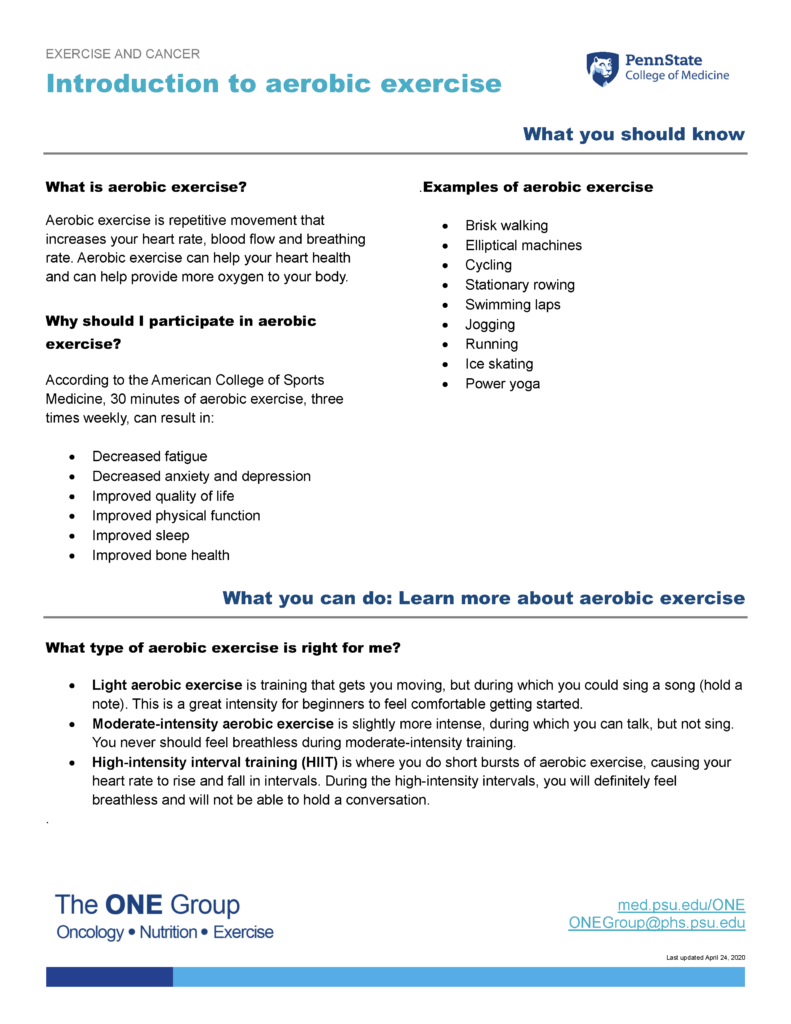Learn the benefits of aerobic exercise for people with cancer in this guide from The ONE Group (Oncology – Nutrition – Exercise) at Penn State College of Medicine.
Jump to topic
Search
What you should know
What is aerobic exercise?
Aerobic exercise is repetitive movement that increases your heart rate, blood flow and breathing rate. Aerobic exercise can help your heart health and can help provide more oxygen to your body.
Why should I participate in aerobic exercise?
According to the American College of Sports Medicine, 30 minutes of aerobic exercise, three times weekly, can result in:
- Decreased fatigue
- Decreased anxiety and depression
- Improved quality of life
- Improved physical function
- Improved sleep
- Improved bone health
Examples of aerobic exercise
- Brisk walking
- Elliptical machines
- Cycling
- Stationary rowing
- Swimming laps
- Jogging
- Running
- Ice skating
- Power yoga
What you can do: Learn more about aerobic exercise
What type of aerobic exercise is right for me?
- Light aerobic exercise is training that gets you moving, but during which you could sing a song (hold a note). This is a great intensity for beginners to feel comfortable getting started.
- Moderate-intensity aerobic exercise is slightly more intense, during which you can talk, but not sing. You never should feel breathless during moderate-intensity training.
- High-intensity interval training (HIIT) is where you do short bursts of aerobic exercise, causing your heart rate to rise and fall in intervals. During the high-intensity intervals, you will definitely feel breathless and will not be able to hold a conversation.
How to get started
- Start by setting aside 10 to 15 minutes a day, three times a week. Start at an intensity level that is comfortable and increase gradually.
- For example, start by walking 10 minutes a day, three times a week. Then increase your walking time by a few minutes every week.
How hard should my workout be?
- A rating of 0 means that you’re not doing any exercise and are resting. A rating of 10 means that your body is working the hardest it can – like running to catch a bus.
- As you begin your aerobic training, try to exert yourself so that you’re rating your workout between a 3 and 4.
- After you feel you have made some positive progress, try and push yourself so that you’re increasing your difficulty rating to the 4 to 6 range. This is called “moderate intensity.” At this intensity, you should be able to speak in sentences without becoming completely out of breath.
- If at any point you feel any unexpected pain or soreness, decrease the intensity of your exercise session.
- A rating of 9 and 10 is excessive.
Intensity scale at a glance
- 10 – Maximal effort – as hard as you have ever worked
- 9
- 8 – Very hard
- 7 – Moderately hard
- 6
- 5 – Hard
- 4 – Somewhat hard (starting to breathe harder)
- 3 – Moderate
- 2 – Somewhat easy – like walking around your home
- 1 – Very easy
- 0 – At rest
Things to remember
- Talk to your doctor before starting a new aerobic exercise plan.
- Stay hydrated. Drink eight ounces every 15 minutes of your workout.
- Don’t exhaust yourself. Avoid this by tracking how hard you are working.
- Pick an exercise that you are most likely to do and stick with it. Don’t make it hard on yourself.
- It is never too late to start.
Where can I find more information about aerobic and strength-training exercises?
If you are interested in starting aerobic and/or strength-training exercises, The ONE Group (Oncology – Nutrition – Exercise) provides videos demonstrating proper form for more than 50 exercises.
Notes
Contact your physician if:
You have a history of diabetes, cardiovascular disease, asthma or osteoarthritis, or if you are obese.
References
- American Cancer Society
- American College of Sports Medicine Moving Through Cancer initiative
- American Institute for Cancer Research
- Academy of Nutrition and Dietetics
- Mayo Clinic
- National Cancer Institute

